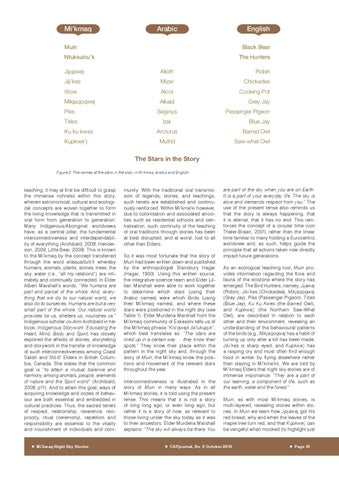Mi’kmaq
Arabic
English
Muin
Black Bear
Ntuksuinu’k
The Hunters
Jipjawej
Alioth
Robin
Jiji’kes
Mizar
Chickadee
Wow
Alcor
Cooking Pot
Mikjaqoqwej
Alkaid
Grey Jay
Ples
Seginus
Tities
Izar
Ku ku kwes Kupkwe’j
Passenger Pigeon Blue Jay
Arcturus Mufrid
Barred Owl Saw-whet Owl
The Stars in the Story Figure 2. The names of the stars in the story in Mi’kmaq, Arabic and English.
teaching, it may at first be difficult to grasp the immense richness within this story, wherein astronomical, cultural and ecological concepts are woven together to form the living knowledge that is transmitted in oral form from generation to generation. Many Indigenous/Aboriginal worldviews have, as a central pillar, the fundamental interconnectiveness and interdependability of everything (Archibald, 2008; Henderson, 2009; Little Bear, 2009). This is known to the Mi’kmaq by the concept transferred through the word elitasualtulti’k whereby humans, animals, plants, stones, trees, the sky, water (i.e., “all my relations”) are intimately and continually connected. In Elder Albert Marshall’s words, “We humans are part and parcel of the whole. And, every thing that we do to our natural world, we also do to ourselves. Humans are but a very small part of the whole. Our natural world provides for us, shelters us, nourishes us.” Indigenous scholar Jo-Ann Archibald in her book, Indigenous Storywork: Educating the Heart, Mind, Body and Spirit, has closely explored the effects of stories, storytelling and storywork in the transfer of knowledge of such interconnectiveness among Coast Salish and Stó:lō Elders in British Columbia, Canada. She states that the common goal is “to attain a mutual balance and harmony among animals, people, elements of nature and the Spirit world” (Archibald, 2008, p11). And to attain this goal, ways of acquiring knowledge and codes of behaviour are both essential and embedded in cultural practices. Thus, the sacred tenets of respect, relationship, reverence, reciprocity, ritual (ceremony), repetition and responsibility are essential to the vitality and nourishment of individuals and com-
• Mi’kmaq Night Sky Stories
munity. With the traditional oral transmission of legends, stories, and teachings, such tenets are established and continuously reinforced. Within Mi’kma’ki however, due to colonisation and associated atrocities such as residential schools and centralisation, such continuity of the teaching of oral traditions through stories has been at best disrupted, and at worst, lost to all other than Elders. So it was most fortunate that the story of Muin had been written down and published by the anthropologist Stansbury Hagar (Hagar, 1900). Using this written source, the integrative science team and Elder Lillian Marshall were able to work together to determine which stars (using their Arabic names) were which Birds (using their Mi’kmaq names), and where these stars were positioned in the night sky (see Table 1). Elder Murdena Marshall from the Mi’kmaq community of Eskasoni tells us of the Mi’kmaq phrase “Klo’qwejk ila’lukupjik”, which best translates as: “The stars are lined up in a certain way … they know their spots.” They know their place within the pattern in the night sky and, through the story of Muin, the Mi’kmaq know the positions and movement of the relevant stars throughout the year. Interconnectiveness is illustrated in the story of Muin in many ways. As in all Mi’kmaq stories, it is told using the present tense. This means that it is not a story of long long ago, or even long ago, but rather it is a story of now, as relevant to those living under the sky today as it was to their ancestors. Elder Murdena Marshall explains: “The sky will always be there. You
are part of the sky when you are on Earth. It is a part of your everyday life. The sky is alive and demands respect from you.” The use of the present tense also reminds us that the story is always happening, that it is eternal, that it has no end. This reinforces the concept of a circular time (von Thater-Braan, 2001) rather than the linear time familiar to many holding a Eurocentric worldview and, as such, helps guide the principle that all actions taken now directly impact future generations. As an ecological teaching tool, Muin provides information regarding the flora and fauna of the ecozone where the story has emerged. The Bird Hunters, namely, Jijawej (Robin), Jiki’kes (Chickadee), Mikjaqoqwej (Gray Jay), Ples (Passenger Pigeon), Tities (Blue Jay), Ku Ku Kwes (the Barred Owl), and Kupkwe’j (the Northern Saw-Whet Owl), are described in relation to each other and their environment, revealing an understanding of the behavioural patterns of the birds (e.g., Mikjaqoqwej has a habit of turning up only after a kill has been made, Jiki’kes is sharp eyed, and Kupkwe’j has a rasping cry and must often find enough food in winter by flying elsewhere rather than staying in Mi’kma’ki). We are told by Mi’kmaq Elders that night sky stories are of immense importance: “They are a part of our learning, a component of life, such as the earth, water and the forest.” Muin, as with most Mi’kmaq stories, is multi-layered, revealing stories within stories. In Muin we learn how Jipjawej got his red breast, why and when the leaves of the maple tree turn red, and that Kupkwe’j can be vengeful when mocked (to highlight just
• CAPjournal, No. 9 October 2010
• Page 16
